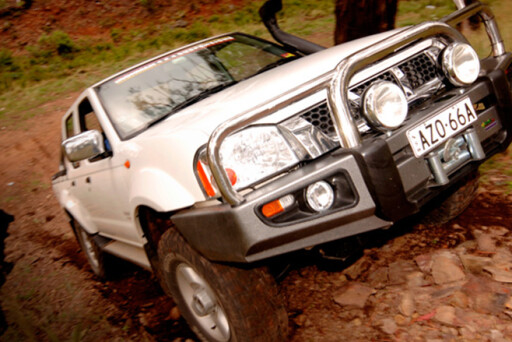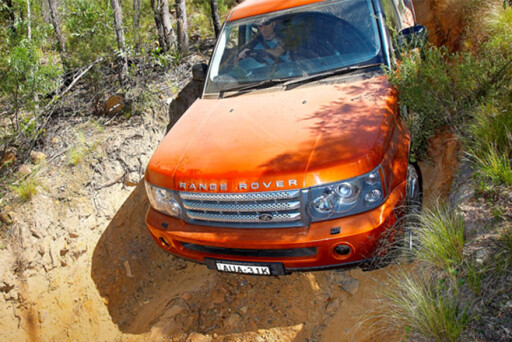.jpg )
Ascending or descending steep slopes is a 4X4 challenge for which you must be properly prepared. Coming unstuck, literally, could be catastrophic if all you can do is panic.
Australia’s topography is such that, unless you live way out in the flat, featureless plains that dominate much of the outback, most four-wheel drivers will have ready access to mountainous terrain reasonably close to home.
For millennia rivers have cut deep gorges, while volcanoes long ago pushed ripples of once molten rock skyward to leave a landscape of some white knuckle ups and downs upon which we can test our mettle.
They key principles for the correct approach to anything steep are traction – keep the wheels on the ground as much as possible, that way you’re maintaining drive – and low speed in the right gear so that you avoid wheelspin or stalling your 4X4.
Going at a steep climb like a bull at a gate to use pure speed to carry you through is just asking for trouble. Rocks, ruts, and erosion mounds hit hard can upset your line, not to mention damage your vehicle (or the track), forcing an unnecessary recovery. But we’re getting ahead of ourselves.
GOING UP

You should’ve already adjusted tyre pressures for off-road use but, standing at the foot of an ascent, an assessment of the surface to be climbed should indicate whether you need to lower them further. Take the time to walk the track; are there ruts, ridges or holes to traverse? Is the surface material loose or sharp? Is it a gradual climb to the end or does it head sharply upward near the top?
It’s no good turning a blind corner to be faced with an incline beyond you or your vehicle’s capabilities. And if you suddenly need to change gear in a manual you must be able to manage it deftly enough to avoid stalling or rolling backwards. It’s easy enough on the flat, but mistakes can be made if you’re unexpectedly flustered. So, assess the challenge from start to finish.
The line you choose must allow all four wheels to remain in contact with the ground as much as possible. Engage the centre diff lock (if you have one) so that even if you start to paw the air with a tyre the axle at the other end still has drive apportioned to its wheels. It’s crucial to remember that with open differentials (or an unlocked centre) as soon as a wheel leaves the deck the drive is sent to the wheel with the least resistance – the spinning one – so you’ve lost drive and therefore traction.
In any vehicle low range should be selected; low second or possibly third is a good start for manuals, which leaves one or two more ratios should the incline increase or you start to run out of puff. With an auto, using low three, two or one, and not drive, offers more control.
Once underway aim to keep the revs in the powerband and maintain a controlled progress. One aid to this is to rest your right foot against the footwell wall while applying the accelerator, which helps combat unsteady input (or lift-off) if the going is rough or undulating.
If needs be, gentle acceleration could be applied to help clear a hole or rut over which you might lose traction.
The hardest part of driving up steep inclines is remembering exactly where the obstacles lie as you travel over them because, simultaneously, you must be plotting the course through what you can see beyond your bonnet. Further, as you steer to negotiate or, say, straddle a long rut and then turn, you must allow for the fact that your rear wheels will travel in a smaller arc than the front.
Forget this and you could be jolted as a rear wheel drops and one (or if it’s a deep enough hole even two) front wheels reach for the sky.
Again, a walk of the track first would have allowed you to spend some time road building by stacking rocks in any depression that looks like it may hinder slow-moving wheels.
Avoid using timber which could break under the weight of your vehicle and spear its undercarriage or jam and halt your progress.
If you’re travelling in a convoy it’s good practice to wait until the vehicle in front has successfully completed the section and is clear of the track. That way you have a clear run. If the 4X4 in front becomes stuck, and you’re right behind it, you may have to stop on a dangerous or unsuitable part of the climb. You then may have to extricate yourself backwards if the stricken rig can’t proceed.
If it comes to the point where forward progress halts altogether, depending on what stopped you dictates the course of action now required.
Did you run out of traction/gears? Will the handbrake hold the vehicle? Do you absolutely have to continue? Is there available recovery equipment to haul you to the top or lower you back down? If the last two answers are negative then the following reverse stall start recovery should be employed. And if you were sliding backwards then you’d better know the routine off by heart.
In any case, you need to be in reverse gear ASAP. In a manual vehicle, if you’re stalled and/or sliding, grab reverse gear, keep your foot off the clutch and brakes and start the vehicle to quickly restore drive and grip.
In an auto, you need to select neutral, start the vehicle and then grab reverse.
When backing down only use your side mirrors for guidance, don’t be tempted to look over your shoulder as the movement to physically turn could cause you to over steer the 4X4 into the verge or off the side of the track.
It’s a good idea to really practice this technique on gentle grades before using it for the first time in an emergency.
GOING DOWN

There are many similarities in technique for safely descending slopes as we’ve outlined above. Walking the track first, checking for obstacles, road building and wheel contact through line choice are just as applicable and important.
Gear selection is still low range, however it’s more likely that low first will be the cog you choose, depending on your vehicle, although in manual rigs like Defender and 70 Series low two or three may suffice on all but the steepest hills.
It’s all about engine braking and traditionally manual diesels offer much more of this security blanket than autos of either fuel persuasion.
A lockable centre diff comes into its own; maybe more so heading downhill than going up. For the same fact that drive is apportioned to the wheel offering least resistance, descending takes on new danger if one front and one rear lift off. The vehicle will take on the qualities of a toboggan. Where fitted, lock the centre and rear diff locks.
Engine braking alone, even in low first, may still need to be augmented by gentle foot brake application to control descent speed, again, more so in autos. One operation to be avoided if possible on a steep descent in a manual is a gearshift.
Your selection might not make it home, never mind using the clutch – you run the risk of a runaway if you’re sloppy or careless about it. If it becomes apparent you need to swap cogs, gently apply the footbrake, select the gear, back off the clutch pedal until you feel the engine’s compression slow the vehicle and then gently release the brake.
If you have to manually change gear going either up or down utilise the flat spot afforded by an erosion mound common to most off-road bush tracks.
Even heading downhill it’s possible to stall the vehicle. The forward stall start procedure mirrors the reverse technique, however, if you’re not sure what caused the stall – and the vehicle will hold on compression – apply the handbrake and either ask your passenger (if equipped) to or jump out yourself and remove obstacles that may be lodged.
When you’re sure that your wheels are unimpeded, back in the cab, in a manual vehicle, select low-first and release the handbrake. While covering the footbrake with your right foot start the vehicle in gear and continue.
In an auto, select neutral and, with the footbrake firmly applied, start the vehicle before slotting home low first and controlling the vehicle’s take off under gentle braking.
With either transmission it’s imperative that the vehicle is re-started in gear as soon as possible if it starts to slide while stalled, to give yourself the fastest opportunity to regain control.
A final point that should be stressed is that steep terrain is best avoided in the wet. Even with extreme caution the possibility of breaking traction completely is very high, which would result in a total loss of control.
If you find yourself in mountainous country when the weather closes in it’s probably wise to stay put until conditions dry out. If camping for the weekend you may not make it in to work on Monday morning, but consider the alternatives. Self preservation is a great reason to stay in the bush that bit longer.
Get the latest info on all things 4X4 Australia by signing up to our newsletter.

COMMENTS